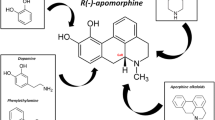Abstract.
This study evaluated the efficacy in Parkinson's disease (PD) of a new pharmacologic preparation of apomorphine included in microemulsions and administered by transdermal route, which provides a constant release of the drug for several hours (Apo-TD). Twenty-one PD patients with motor fluctuations were treated with L-dopa alone, with L-dopa plus oral dopamine-agonists, or with L-dopa plus Apo-TD. Apo-TD improved UPDRS-III and tapping test scores in “off” conditions, and reduced duration of “off” periods; no improvement in “on” conditions occurred. We conclude that Apo-TD shows its efficacy particularly by reducing “off” period duration and disability rather than improving motor performances in “on” conditions and therefore it seems a promising treatment for uncontrolled “off” phases in PD patients.
Similar content being viewed by others
Author information
Authors and Affiliations
Additional information
Correspondence to L. Priano
Rights and permissions
About this article
Cite this article
Priano, L., Albani, G., Calderoni, S. et al. Controlled-release transdermal apomorphine treatment for motor fluctuations in Parkinson's disease. Neurol Sci 23 (Suppl 2), s99–s100 (2002). https://doi.org/10.1007/s100720200088
Issue Date:
DOI: https://doi.org/10.1007/s100720200088




